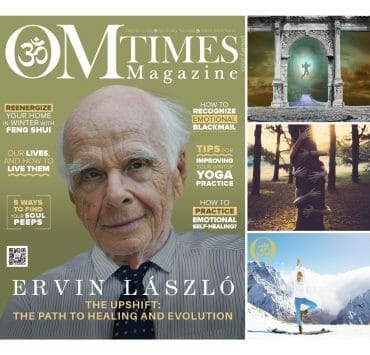Ervin László: The Upshift

Sandie Sedgbeer: If people started taking the steps that you advocate now, and now is the only time you know that they should be doing that, how long do you think it would take to turn things around?
Ervin László: Next week!
Sandie Sedgbeer: Next week?
Ervin László: Yes. Things could go very fast. You see, the way ideas spread, insights, and beliefs spread can be very rapid. There’s an openness now because the old ways of thinking, believing, and feeling are breaking open.
The danger is that before reaching the new, natural way, you may break down in depression, fear, the negative attributes. But if you don’t break down in between, we reach the next level, and the next level will be beyond what we have today. So you have a higher level of up-shifted level, which could go very fast. Sure. Next week could be next year, but we don’t have much time. We don’t have decades. We have years. So let’s get going with it.
Sandie Sedgbeer: We have a situation in England right now, especially in London, where many people concerned about climate change are taking radical actions. They are sitting on freeways and blocking traffic for hours on end. They’re standing on big bridges, et cetera. They’re doing all kinds of things. The other day, a young woman in her mid-twenties was reported standing on top of one of our major bridges. They had to close the bridge down, and all the traffic and the public were annoyed because they could not continue their normal daily life. But this young woman was crying, but she said, I know that everybody is going to hate me for what I’m doing, but you are robbing me of my future. And it was such an emotive thing to hear and see this young woman crying and taking such radical action, knowing that it would make her very unpopular. What would you advise that some of these young people do instead?
Ervin László: Well, it’s fine to take individual action, but you’re exposing yourself to a great deal of criticism and a blockage. Try to create a movement, try to bring other people together. But, of course, great sudden movements that happened very quickly in the 20th century were mostly negative. Not all, because Gandhi’s insight led to India’s independence and a new way of looking at things. There was Castro’s attempt to create a more egalitarian society in Cuba, but most of the great movements that got going very fast had negative consequences. Lenin started very positively. He started to create a more collective, a new human, as you call it, a new society, a proletarian society. But he did it by counter-posing it to a negative movement, to the capitalist Movement.
So we are fighting the proletarian struggle fighting the capitalists and finding free enterprise. That became a very negative struggle among political groups. But the principle was good, actually, I must say. And there was also Mao in China, that completely reformed from the Hsinhai one day to the next and practically reformed the entire Chinese system, moving it to this new level. Not necessarily all the way. It could continue to be a racist practice. Still, it changed the future system tremendously into a completely different one. So things can move very fast, very, very fast. And when good ideas catch hold, they also can move. Good ideas can go very deep. There was a being of this Earth on this planet whose beliefs whose personality created the last change that changed the world forever. So as known as Jesus Christ and the love that he brought forth radiated inspired some disciples, and those disciples inspired some more.
And despite the repression of the classical Roman empire, this Movement survived and spread and became Christianity as a force in the world. Tremendous events happened from Hitler to Jesus. You know, the largest possible contrasts. So this is just a response to the question. How long would it take? It can go very fast, but the deep changes take time to happen. But to keep in mind that the time is not likely to be very long because we don’t simply have a long time for change to happen. Things will break down if we don’t act in time or make the change happen.
So let’s not worry about the time, let’s start it, and it will go. It’s, it’s a snowball effect. It’s a butterfly effect. You know, the idea of the butterfly effect of a butterfly flapping its wings in California? We create a storm in Mongolia.
It Amplifies. And It amplifies because we are dealing with a so-called turbulence system. It’s a non-linear system. Lots of things can happen from one moment to the next. And this led the anthropologist Margaret Mead to say never doubt the power of a small group of people to change the world. I shared it. Nothing else ever had. I was still adding another thing. Nothing else ever had. Especially when the world is unstable and it’s already on the point of bifurcation, then the change can be very fast. So I’m optimistic about change, being able to happen and happen fast.
Sandie Sedgbeer: The Russian writer Leo Tolstoy once said that the people who are crazy enough to think they can change the world are the ones who do. So I guess we all need to get a bit crazier.
Ervin László: Yes, I think it’s almost necessary, but this means being a hopeful monster. Let me come up with this last discussion, the last metaphor. Some biologists some decades ago came up with this concept of the hopeful monster. The hopeful monster is simply a mutation in a species ahead of its time. Which is now a monster because it doesn’t fit the rest. And it’s being exposed and expelled from the rest cause it’s not understood. But then the change occurs when the mutation happens elsewhere to become the new species’ forerunner. So that’s why it’s hopeful, but right now, it’s a monster. So I would say let’s be more and more hopeful monsters.
Sandie Sedgbeer: I think that’s a really good note to end the show on Ervin László: thank you so much for joining us today.
Ervin László:And it’s really was seriously a great pleasure on your part. So that you and your network are doing a wonderful job. So it was my pleasure and privilege to talk with you.
Sandie Sedgbeer: Ervin László is a Hungarian Polymath, a philosopher of science, systems theorist, integral theorist, and originally a classical pianist. He is an advocate of the theory of quantum consciousness.
THE UPSHIFT: The Path to Healing and Evolution on Planet Earth is the latest and most essential contribution to peace and well-being by Ervin Laszlo, considered one of the greatest thinkers and humanists of our time. His book is an antidote to the pessimism and inaction that spreads worldwide. It shows that we can meet the challenges that face us—the challenges of war and aggression, climate change and destitution, and the virus pandemic. Two paths are opening for us today: a path UP to healing and evolution and a path DOWN to crises and chaos. This book tells you how you can move upward and upshift to a better world. Those who have read its advanced drafts consider it a must-read for every awakened and responsible person on the planet. Open its pages and see why. It could change you and change the world around you.
If you want more information about Irving Leslie’s work, his books, and the upshift movement, visit upshiftmovement.com and ErvinLászlóbooks.com
Click HERE to Connect with your Daily Horoscope on OMTimes!
Visit Our Astrology Store for Personalized Reports
OMTimes is the premier Spiritually Conscious Magazine. Follow Us On Facebook, Twitter, Instagram, Linkedin, Pinterest, and Youtube
A veteran broadcaster, author, and media consultant, Sandie Sedgbeer brings her incisive interviewing style to a brand new series of radio programs, What Is Going OM on OMTimes Radio, showcasing the world’s leading thinkers, scientists, authors, educators and parenting experts whose ideas are at the cutting edge. A professional journalist who cut her teeth in the ultra-competitive world of British newspapers and magazines, Sandie has interviewed a wide range of personalities from authors, scientists, celebrities, spiritual teachers, and politicians.







